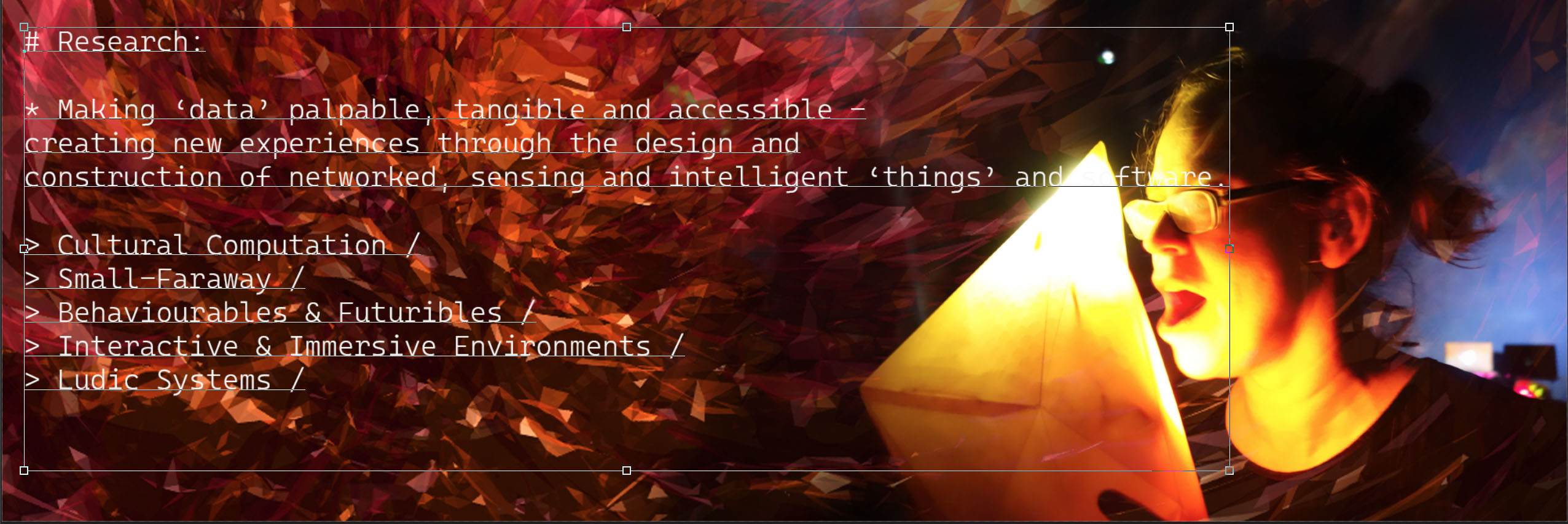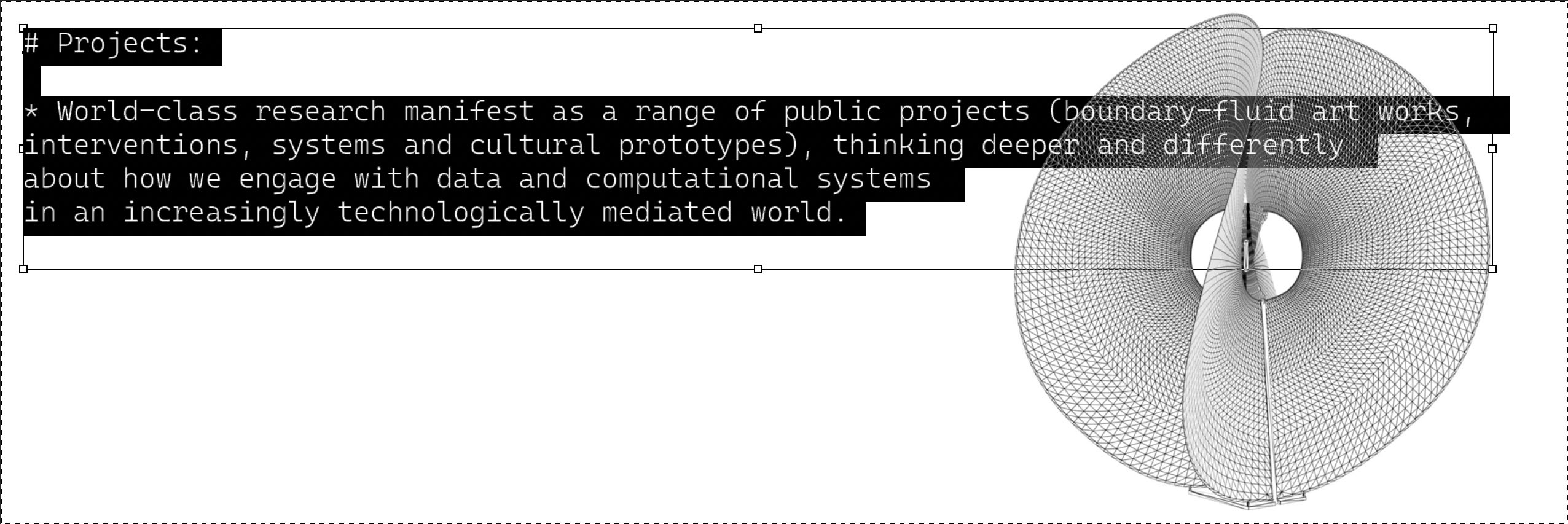Remote Sensing: Ecoid Workshop.
The Ecoid Workshop will be delivered by Luis Girao with support from Mike Phillips, Chris Saunders, Pete Carss, Musaab Garghouti.
“Idly, he wondered what these geometric forms really represented – he knew that only a few seconds earlier they had constituted an immediately familiar part of his everyday existence – but however he rearranged them spatially in his mind, or sought their associations, they still remained a random assembly of geometric forms.”
(Ballard, JG)
……………………………………………………………………………………………………………..


i-DAT is developing a range of ‘Operating Systems’ which dynamically manifest data as experience and extend human perception. Arch-OS [www.arch-os.com], an ‘Operating System’ for contemporary architecture (‘software for buildings’) was the first i-DAT ‘OS’, developed to manifest the life of a building (currently being installed as the i-500 (www.i-500.org) in Perth Western Australia. More recently S-OS was released (Social Operating System) and follow up with Eco-OS, an ecological operating system.
Eco-OS explores ecologies. Eco-OS further develops the sensor model embedded in the Arch-OS system through the manufacture and distribution of networked environmental sensor devices. Intended as an enhancement of the Arch-OS system Eco-OS provides a new networked architecture for internal and external environments. Networked and location aware data gathered from within an environment can be transmitted within the system or to the Eco-OS server for processing.
Eco-OS.
Eco-OS collects data from an environment through the network of ecoids and provides the public, artists, engineers and scientists with a real time model of the environment. Eco-OS provides a range of networked environmental sensors (ecoids) for rural, urban, work and domestic environments. They extend the concept developed through the Arch-OS and i-500 projects by implementing specific sensors that transmit data to the Operating Systems Core Database. Eco-OS also enables the transmission of data back to the Eco-OS ecoids to support interaction with the environment (such as light shows and the transmission of audio/music in response to the network activity).
Descriptor:
Eco-OS: Eco-OS consists of: the Core database, which collects, stores and makes available data and the sensors – ecoids.
Eco-OS Core Database: is an extension of the established Arch-OS Core database. The Eco-OS Core collects the data transmitted to it by the ecoids. The data is parsed up and published through a range of flexible tools (flash, Max MSP, Processing, Java, etc), feeds (xml, rss) and web 2.0 streams, such as Twitter and Facebook, which allow artists, engineers and scientists to develop visualisations, sonifications (music) and interactive projects. Eco-OS can operate in passive mode, simply collecting data from the environment or interactive mode, feeding back recursively through the environment.
Ecoids: are sensor devices (small pods) that can be distributed through an environment (work place, domestic, urban or rural). The sensors allow environmental data to be collected from the immediate vicinity. The sensors can be connected together through the formation of Wireless Sensor Networks (WNS) that enable the coverage of an extensive territory (several kilometres). Each ecoid has a unique id and its location within a network can be triangulated giving its exact location. Consequently locative content can be tailored to a specific geographical area.
Ecoids consist of programmable (Processing, Java, etc) embedded technologies (Arduino, etc) and network technologies (Zigbee/Xbee, GPRS and Bluetooth). Designed to be attached to objects (architecture, trees, rocks, etc), free form (water-based, balloons, free standing) or as mobile sensors. They can be powered or draw power from the environment (solar).
Ecoids can also be used to produce content be receiving instructions from Eco-OS. Distributed performance can then be orchestrated across a large territory through light displays or acoustic renditions.
……………………………………………………………………………………………………………..
Timetable:
SMB302 is free from 11.00 to 17.00 on Friday 22nd, smb302 is free again on Monday 25th from 09.00 until 13.00 and SMB 303A if free on Tuesday from 09.00 until 17.00 hrs.
Friday 22/01/2010:
11.00 – 17.00: Introduction and Hardware Workshop. Smeaton 302.
Saturday 23/01/2010:
Team design work.
Monday 25/01/2010:
09.00-13.00 Further Hardware development. Smeaton 302
09.00-17.00 Software tools and packaging design. Software Babbage 213/221
Tuesday 26/01/2010:
Software and visualisation
Smeaton302 is available all day.
Wednesday: 27/01/2010
10-12. Final production and cleaning up. Babbage213
……………………………………………………………………………………………………………..
Teams:
Teams will consist of 4-5 people. A mix of hardware, software, visualisation and product design skills is encouraged. Ideally PhD, Masters, MPT and DAT students should constitute these teams.
……………………………………………………………………………………………………………..
Construction: The Smeaton labs will support the electronics development.
Kits consist of: Xbee Pro, Sensors (Humidity Sensor, Light Sensor, Temperature Sensor, Stretch sensor), Batteries, and connectors.
Please bring your laptops to allow better connectivity with the systems (University ports/restrictions etc can cause problems).
……………………………………………………………………………………………………………..
Software/plugins:
Xbee interface, php, Processing, Java, Flesh, VVVV, Quartz Composer, www.nodebox.net
http://www.arch-os.com/downloads.html
……………………………………………………………………………………………………………..
Construction: electronics workshop developing the xbee hardware systems.
Interface: connecting the xbee to a PC.
Network: Mesh network of xbee ecoids.
Broadcast: xml feeds from the xbee network to the internet.
Visualisation: generatibg visualisations from the xbee feed.
……………………………………………………………………………………………………………..
Tools:
Mobile: rss feeds, java apps, pachube for iPhone.
Dome: 3D Studio max, Blender, Unity 3D, Quartz Composer (and audio).
GreenScreen. Greenscreen templates.
Web: Pachube.com, etc…
……………………………………………………………………………………………………………..
Collaborators:
These individuals and organisations will be building on this Far Away So Close workshop. There are of opportunities for involvement in these collaborations if you would like to taker this work further.
1: Dr Chris Speed: Edinburgh College of Art: http://ubiquityjournal.net/
Check out the PHYLOGENY WORKSHOP. SAT 20 – SUN 21 FEB 2010
2: Centre for Contemporary Art and the Natural World. www.ccanw.co.uk
3: North Devon Biosphere Reserve. http://www.northdevonbiosphere.org.uk/
4: James Moore. University College Falmouth. http://www.falmouth.ac.uk/
5: Aichi Prefectural University of Fine Arts and Music, Nagoya, Japan. And festival: http://setouchi-artfest.jp/
……………………………………………………………………………………………………………..




You must be logged in to post a comment.